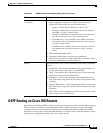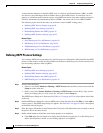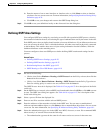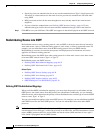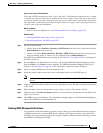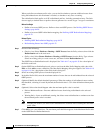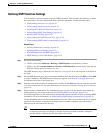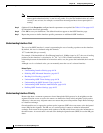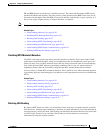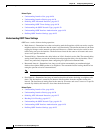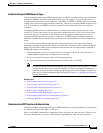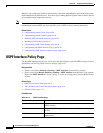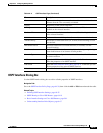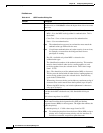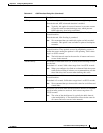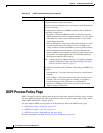
64-27
User Guide for Cisco Security Manager 4.4
OL-28826-01
Chapter 64 Configuring Routing Policies
OSPF Routing on Cisco IOS Routers
DR and BDR election is performed via the Hello protocol. The router with the highest OSPF priority
becomes the DR for that segment. The same process is then repeated for the BDR. In the case of a tie,
the router with the higher router ID (RID) is elected. By default, each interface is given a priority of 1,
but you can assign a higher priority to selected interfaces, as required.
Note The priority setting does not apply to point-to-point, nonbroadcast interfaces.
Related Topics
• Understanding Interface Cost, page 64-26
• Disabling MTU Mismatch Detection, page 64-27
• Blocking LSA Flooding, page 64-27
• Understanding OSPF Timer Settings, page 64-28
• Understanding the OSPF Network Type, page 64-29
• Understanding OSPF Interface Authentication, page 64-29
• Defining OSPF Interface Settings, page 64-25
Disabling MTU Mismatch Detection
The MTU is the largest packet size that a particular interface can handle. If one router sends a DBD
packet that is larger than the MTU setting on a neighboring router, the neighboring router ignores the
packet. In many cases, an MTU mismatch causes the two routers to become stuck in exstart/exchange
state, which prevents OSPF adjacency from being established. This is why it is important that all
neighboring routers share the same MTU setting and that MTU mismatch detection be enabled.
You can, however, disable MTU mismatch detection. This is useful in cases where mismatch detection
is preventing adjacency from taking place in an otherwise valid setup between two devices with different
MTUs.
Related Topics
• Understanding Interface Cost, page 64-26
• Understanding Interface Priority, page 64-26
• Blocking LSA Flooding, page 64-27
• Understanding OSPF Timer Settings, page 64-28
• Understanding the OSPF Network Type, page 64-29
• Understanding OSPF Interface Authentication, page 64-29
• Defining OSPF Interface Settings, page 64-25
Blocking LSA Flooding
By default, OSPF floods new LSAs over all interfaces in the same area, except the interface on which
the LSA arrives. Although some redundancy is desirable, too much redundancy can waste bandwidth. In
certain topologies, such as full mesh, LSA flooding can destabilize the network because of excessive link
and CPU usage. Therefore, you can block LSA flooding to selected interfaces on broadcast,
nonbroadcast, and point-to-point networks.



